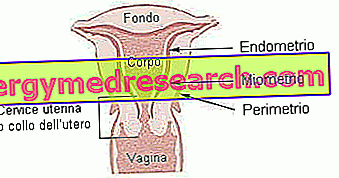Key points
Endometrial polyps are soft, generally benign, features that grow along the endometrium (the mucosa that lines the uterine cavity internally).
Causes
Although a precise cause of origin is not known, it is conceivable that endometrial polyps are the end result of an abnormal response to estrogenic hormonal stimuli.

Symptoms
Endometrial polyps can run completely asymptomatic. Sometimes, however, the presence of a polyp in the endometrium can cause dyspareunia and menstrual discomfort (irregularity, hypermenorrhea, menorrhagia, dysmenorrhea, spotting).
Diagnosis
Endometrial polyps can be confirmed by different investigative investigations, such as: sonosalpingography, hysterosalpingography, curettage and hysteroscopy.
Therapy
Drug therapy (with progestins or gonadotropins) is not always effective. More often, endometrial polyps are removed by hysteroscopy. In case of malignant evolution, we proceed with hysterectomy (removal of the uterus).
Endometrial polyps
Endometrial polyps are cellular proliferations, usually benign, that develop along the endometrium, the mucosa that covers the uterine cavity internally.

Endometrial polyps are a particularly frequent phenomenon in women during the period immediately before menopause. It is estimated that the incidence of endometrial polyps increases as age progresses, and then decreases considerably after the menopause.
- It is rare for polyps in the endometrium to appear around the age of 20-30, as it is unlikely that the disorder will occur after menopause.
What is an endometrial polyp?
An endometrial polyp is a soft and spongy growth consisting of esophytic (or "protruding") mucous cells. Endometrial polyps differ in terms of size, shape and appearance. They can be very small (just a few millimeters) or can reach considerable dimensions (> 2 cm). Moreover, endometrial polyps can develop singularly or create real agglomerates formed by numerous, small, endometrial polyps.
These polyps can adhere to the uterine wall using a peduncle, which allows the polyp to protrude into the vagina when it reaches a considerable size.
The sessile endometrial polyps (also called "broad base") do not have a peduncle and adhere to the uterine mucosa with a small root; therefore they cannot protrude into the vagina.
Causes
The endometrial polyp seems to be the final result of a hyperplastic growth process of the uterine mucosa, in turn caused by an abnormal response to hormonal stimuli.
Although it is not possible to ascertain with absolute certainty the cause involved in the formation of endometrial polyps, it seems that the disorder is related to an alteration of serum estrogen levels.
For this reason, women aged between 40 and 50 years (PRE-menopausal period), presenting a particular estrogenic profile, are more subject to the formation of polyps in the endometrium.
To understand...
Hormonal plasma levels cannot be reported accurately in women during pre-menopause, since they are subject to large and unpredictable fluctuations. The ovaries undergo a progressive decline starting from the premenopause, gradually becoming more atrophic and smaller. As we approach the actual menopause, the hormonal structure becomes more defined: the levels of estrogen - and especially progesterone - are extremely low, while those of FSH (follicle stimulating hormone) and LH (luteinizing hormone) appear high. After menopause, the formation of endometrial polyps is extremely unlikely precisely because of the hormonal stability that characterizes it.
Clinical evidence shows that endometrial polyps tend to occur more often in obese women, especially when the body mass index is equal to or greater than 30. Furthermore, it seems that women are more exposed to the risk of endometrial polyposis in case of previous (or current) intake of antiestrogens, drugs indicated for the treatment of breast cancer and gynecomastia (eg tamoxifen and raloxifene).
In the past it was assumed that hypertension and the previous history of cervical polyps (in the uterine cervix) could constitute risk factors for endometrial polyposis. However, from what emerges from a study reported in the Journal of Obstetrics and Gynecology this hypothesis has been refuted, since no proven and demonstrable association was found.
Symptoms
The presence of a polyp on the endometrium is not always perceived by the woman. More often, in fact, the lesion is diagnosed randomly during a simple gynecological examination.
The symptoms tend to occur when the polyps take on a considerable size.
The clinical picture of endometrial polyposis is characterized by:
- Pain during sexual intercourse (dyspareunia)
- Menstrual irregularity
- Abundant menstruation (hypermenorrhea)
- Painful menstruation (dysmenorrhea)
- Extremely abundant blood loss during menstruation (menorrhagia)
- Uterine loss similar to menstruation during the post-menopausal period
- Bloody vaginal discharge after sexual intercourse
- Spotting (loss of dark uterine blood between two periods)
The symptoms described above must be carefully evaluated by the gynecologist, since they are almost the same as those occurring during endometrial cancer. Consequently, an accurate differential diagnosis is essential.
Most uterine polyps are a benign condition: the probability of degeneration in tumors is very low (<1%).
Endometrial polyps and infertility?
In a sense, some endometrial polyps can be compared to a natural intrauterine device (IUD). This bizarre association is explained by the growth of polyps near the fallopian tubes: the uterine polyp, obstructing the openings of the tubes, prevents the fertilization of the egg cell.
Women presenting endometrial polyps - large species - near the salpingi can undergo infertility. To avoid this inconvenience, surgical excision of the cellular growth is recommended as soon as possible after the assessment.
Diagnosis
The presence of an endometrial polyp is detected by various investigative tests:
- Sonosalpingography: diagnostic test to evaluate the patency of Fallopian tubes in women seeking pregnancy. The test is performed by transabdominal and transvaginal pelvic ultrasound.
- Hysterosalpingography (HSG): radiological test useful for assessing the health of the uterus and tubes. The radiologist, using a catheter or exocervical cups, injects a contrast liquid into the uterine cavity, so as to offer - by X-ray - a clear image of the polyps and other tissues.
- Curettage: consists of the removal of endometrial tissue and subsequent cytological analysis in the laboratory
- Hysteroscopy: fundamental investigation in the differential diagnosis of the various causes of menstrual alteration
Care
The use of drugs for the treatment of endometrial polyps is not the therapeutic option par excellence, given that at the end of the pharmacological treatment the probability that the polyp will recur is very high. However, the possible medical aids are:
- Progestins (eg Norethindrone)
- Gonadotropins or releasing hormone agonists (Leuprolide or Goserelin)
The most appropriate therapy for the removal of endometrial polyps is essentially surgical: the excision of cellular growth favors complete remission of symptoms. The most used surgical strategies for this purpose are:
- Hysteroscopy : complete surgical removal of the uterine polyp
- Hysterectomy : removal of the uterus, indicated when uterine polyps contain neoplastic cells
It should be emphasized, however, that the risk of recurrence is real even after a perfectly successful surgery. For this reason, women who have a past history of endometrial polyposis should undergo more frequent ultrasound / historioscopic checks.



